Identifying Cannabis Plants Problems – Bonza Blog
Identifying Cannabis Plants Problems:
Cultivating cannabis is fun. For some people, growing itself adds to the experience of its use. However, during its journey from seeds to mature plants, problems may occur. For example, growers may encounter nutrient deficiencies, diseases, pests and environmental stresses. While some are minor issues, they could become catastrophic unless taken care of early.
Hence, in this article, we cover most of the likely problems cannabis growers may experience.
- Nutrient Deficiencies
- Diseases
- Pests and Bugs
- Environmental Conditions
- Other Problems
It is a given that the best solution is to prevent one from occurring in the first place. Regardless, when a problem arises, knowing how to identify becomes as much crucial as providing a solution. As such, the goal of this article is to arm growers with the rudimentary knowledge to deal with anything that becomes a hindrance to a successful grow and harvest.
Nutrient Deficiencies
A common occurrence in cultivating cannabis or any plant for that matter is a deficiency in nutrients. Fortunately, the signs are easy to see. As such, adjusting is not at all unmanageable.
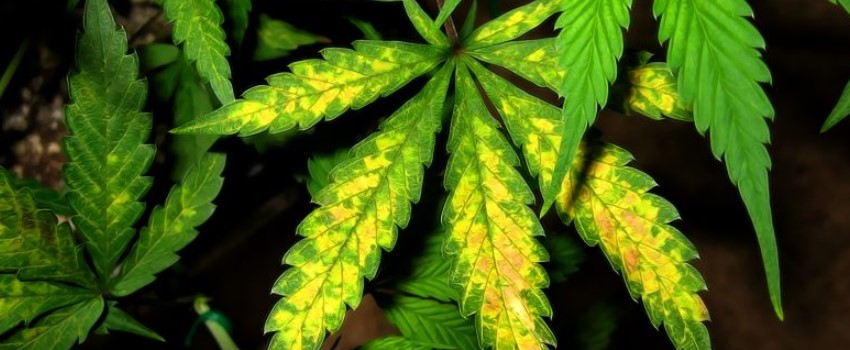
Nutrient Deficiencies – Image powered by Loudclouds.co
Boron
Boron plays a role in different plant processes including maturation, seed production, and protein formation.
Signs of Boron Deficiency
- Uppermost leaves grow
- Takes a long time for leaves to mature
- Leaves appear to be twisted or curled
- Stems become hollow and rough
- Roots grow slowly; secondary roots shorten and swell
Copper
Cannabis plants need copper for photosynthesis, respiration, and metabolism. Although rare, deficiency if not addressed may be fatal.
Signs of Copper Deficiency
- Younger leaves become affected first
- Discoloration is noticeable on the tips of the leaves
- Weird bluish metallic glint
- Flowers in male marijuana plants cannot mature
- Female plants show abnormal stigmas
- Roots grow unusually large and start to decay
Calcium
This nutrient is essential in keeping the cell wall tissues of the plants intact. Aside from this, it also takes part in root development and protein synthesis. Without enough calcium, the plant will show distorted growth.
Signs of Calcium Deficiency
- Leaves turn dark green or have necrotic spots
- New leaves are small and distorted
- Flowers or buds develop slowly
- Branches are weak
- Develop slimy root rot
Iron
Iron facilitates the production of chlorophyll – the green pigment that absorbs light and works with carbon dioxide to make plant food.
Signs of Calcium Deficiency
- Young leaves may turn yellow, but veins are still green
- Minimal bud growth, twisted stems
- Roots may be smelly, brown, and mushy
Magnesium

Nutrient Deficiencies – Image powered by Loudclouds.co
Magnesium prompts the growth of cannabis leaves. As such, it also helps in growing healthy veins.
Signs of Magnesium Deficiency
- The part between veins becomes yellow
- Edges of the leaves look burnt while some have brown spots or a patchy pattern
- The plant withers or sags
Manganese
Manganese plays a role in nitrate assimilation. Once disrupted, the plant starves because of its low capacity to use nitrates in creating protein.
Signs of Magnesium Deficiency
- Leaves become pale
- Some show interveinal chlorosis
- Spots on areas between veins
- Growth is reduced or stunted
Molybdenum
Molybdenum converts nitrate into ammonia to aid in generating protein. As it is essential in plants, protein affects the overall plant growth.
Signs of Molybdenum Deficiency
- Discoloration on the leaves: orange, red, or pink on the edges
- Apparent changes begin in the middle of the plant and moves upward
Nitrogen
Nitrogen is a component of chlorophyll. It is the compound needed by plants to make sugars from water and carbon dioxide. With less nitrogen in the plant’s system, the plant exhibit signs of starvation.
Signs of Nitrogen Deficiency
- Leaves start to turn pale in the lower part of the plant
- Deficiency becomes noticeable as it moves upward
- It starts at the bottom of the plant and shows yellowish leaves
Phosphorus
Phosphorus is needed when the plant reaches its flowering phase. It plays a role in the growth of roots and stems. It also plays a role in photosynthesis in which it converts light into energy. Lacking in phosphorus leads to a low yield.
Signs of Phosphorus Deficiency
- Grows tiny leaves
- Mosaic pattern – some show burnt or dying leaf tips, changes happen from the bottom and move upwards
- Leaves turn a darker shade of green, purple, and blue colors
Potassium
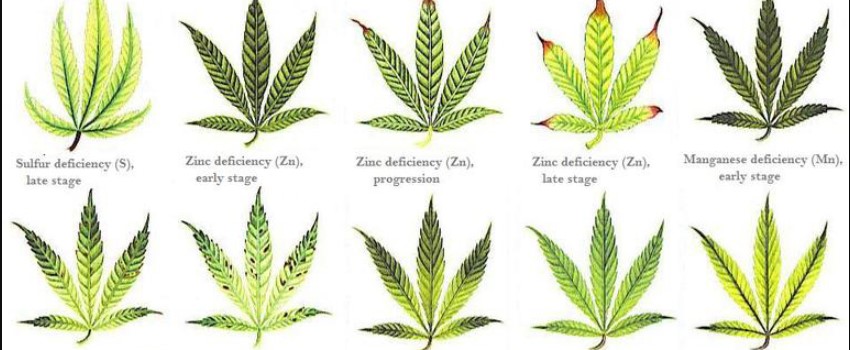
Nutrient Deficiencies – Image powered by Loudclouds.co
Potassium is responsible for many functions. It handles the regulation of carbon dioxide absorption in plants. Aside from that, it activates enzymes. If plants lack potassium, growers may have a hard time dealing with multiple problems related to growth, root development, and seed conditions.
Signs of Potassium Deficiency
- Leaves look scorched and brown
- Chlorosis
- Large spaces between the nodes and that indicates stretching of the stems
- Plant is characterized as being too tall
Sulfur
Sulfur takes care of the development of plant proteins during its vegetation state. If sulfur content is depleted, the process is compromised and takes a toll on the plants.
Signs of Sulfur Deficiency
- Newer leaves turn yellow, orange, or red
- Leaves turn fragile and slim
- Woody stems will keep getting taller, and the plant won’t expand
- Buds may start to die, and the plant’s growth will be stalled in the flowering stage
Zinc
Zinc is involved in producing chlorophyll. It is also a part of the growth hormone auxin. Without these two, the plant will have trouble growing.
Signs of Zinc Deficiency
- Old and new leaves turn yellow
- Tips of the leaves exhibit distorted colors
- Space between the newer nodes is limited
- New leaves may get tangled
Nutrient Burn
Lacking in one or more nutrients can be catastrophic to cannabis plants. However, having too much can also be problematic.
Signs of Nutrient Burn
Diseases

Diseases – Image powered by Growingmarijuanablog.com
Cannabis plants, like people, are also susceptible to diseases. Here are some of the common ones that growers should be aware of:
Algae
Many growers ignore the growth of algae because it seems harmless. However, if the growth becomes excessive, then it can be fatal to the plants.
Signs of Algae
- Leaves become yellow and brown, with dark-colored spotting
- Roots clump together; turns dry and brown
Bud Rot
Gray mold or bud rot is a fungal disease capable of wiping out an entire garden. It thrives in cool, humid, and temperate climates.
Signs of Bud Rot
- Stems turn brown and soft
- Stems may rot and lose rigidity; forms a brownish gray mass which gets covered by fungal spores
Leaf Septoria (Yellow leaf Spot)
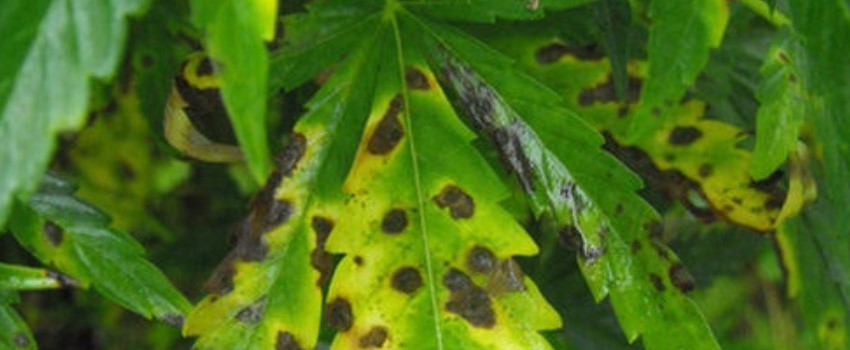
Leaf Septoria – Image powered by Grasscity.com
Fungal pathogens cause leaf septoria. These pathogens are brought about by warm weather and rain. More specifically, it targets cannabis plants grown outdoors.
Signs of Leaf Septoria
- Lower leaves are affected
- Spots are white or grayish brown or yellow, circular lesions present
Powdery Mildew
Powdery mildew comes from different types of fungi. Because of the characteristic “white powder” spreads on the leaves of the plant, it is easy to spot.
Signs of Powdery Mildew
- White powdery substance found on the plant’s green leaves
- Leaves become pale in color
- Damp smell coming from buds
- Entire plant turns to yellow or brown
Fusarium

Fusarium – Image powered by Thejointblog.com
A type of fungus that lives in soil, fusarium has the potential to kill cannabis plants.
Signs of Fusarium Wilt
- Little dark spots on the lower leaves
- Turns yellowish brown
- Tips turn upward and wilting occurs
Fusarium Root Rot
- Stem swells and breaks open; possible collapse
- Roots turn red
Verticillium Wilt
A fungus can also cause verticillium wilt. The plants that attract this disease are the ones that are in grown in rich soil or those with stressed roots.
Signs Verticillium Wilt
Leaves found at the base start to yellow while others become a grayish brown color
Stem turns brown especially the part close to the soil
Root Rot
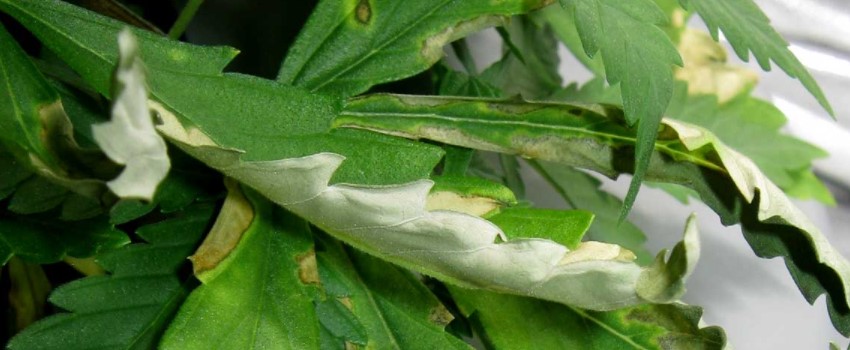
Root Rot – Image powered by Growweedeasy.com
Pythium or root rot is the disease that targets the root of the cannabis plants. Due to underlying conditions, the roots of plants may already be weak. As such, the opportunistic disease takes advantage of that.
Signs of Root Rot
- Leaves have burnt brown spots
- Yellow or white colored leaves
- Leaves fall off
- Roots are off-colored, soft, and watery
- Root external layer falls off
- Rotting smell coming from the roots
Damping Off
Due to unequal distribution of nutrients because of complications brought on by diseases, damping off occurs. It results in weak stems that are soft and mushy. Unless rectified, it may cause the plant to topple and die.
Signs of Damping Off
- Leaves and stems have a yellow or brownish discoloration
- Lesions between nodes, red and brown cankers
- Plant collapse
Pests and Bugs
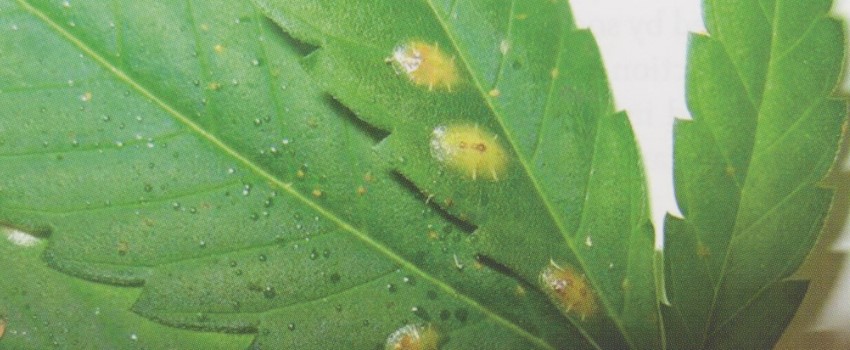
Pests and Bugs – Image powered by Pinterest.ie
Pests and bugs are also common, and growers need to do everything that they can to stop them. As these are likely to interfere with plant growth, it’s best to take preventive measures against these creatures.
Ants
Ants are insects that are quite attracted to sugar. Often seen lurking in the kitchen, they do not affect your plants directly. However, in the garden, it can cause damage to the root systems of plants. Not only that but they also signal underlying problems like aphid infestations.
Aphids
These are pale and tiny pests in plants that are so small that they are easy to miss. Some growers fail to see them because they hide under the sides of cannabis leaves. But these little creatures can cause problems by draining the plants of essential nutrients.
Birds
For outdoor growers, this animal is a friend and an enemy. First, birds are quite helpful in getting rid of pests like caterpillars and worms. But they can also turn out to be the enemy if allowed to touch plants during germination. That is because they happen to love eating seeds.
Caterpillars
Caterpillars just love to eat plants. These creatures have a voracious appetite and like aphids can go unnoticed until cannabis leaves are all gobbled up and gone. There is also a different type of caterpillar that likes to stay inside the plant and eat the interior. Growers need to be meticulous, or they might end up with hollow and dead plants.
Cats and Dogs
Canines bring destruction by digging the soil of the garden. Aside from that, urine and fecal matter are two other things that may cause harm such as harboring other pests and parasites. The last thing that growers want is a garden full of urine, poop, and creepy crawlies wreaking havoc.
Cutworms
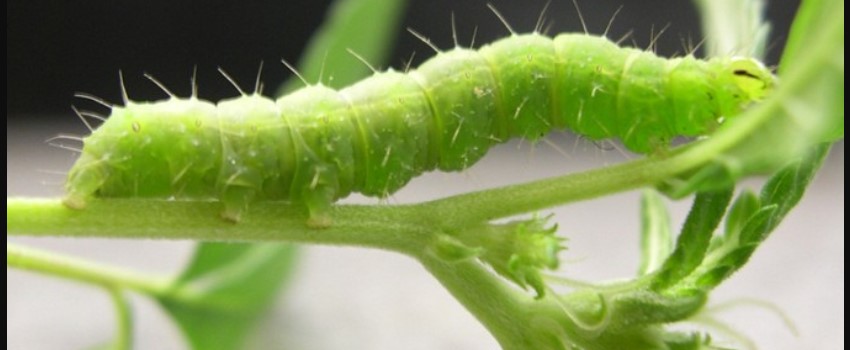
Cutworms – Image powered by Forum.sensiseeds.com
Cutworms can destroy seedlings. Naturally stealthy, it is difficult to catch because growers can only see it in action at night.
Crickets and Grasshoppers
Crickets and grasshoppers are everywhere. From flower gardens to farms, there is no escaping these terrible pests. Even worse, they have quite a big appetite for plants. Unless controlled, they might end up eating everything in the garden.
Deer
As adorable as deer are, they can also be a menace. It so happens that these herbivores are attracted to cannabis plants. Unless the garden is fenced, they can come roaming freely and feed on the plants.
Fungus Gnats
Fungus gnats attack the stems and roots of the plants. It first starts with the lower part of the stem before making its way towards the root system. Keep in mind, any trouble with the root system of the cannabis plant may result in growth abnormalities.
Gophers and Moles

Gophers and Moles – Image powered by Greencultured.co
Growers should be aware of gophers. They attack the root system of plants. Fortunately, it does not appear to target cannabis plants. Moreover, they help its growth by eating other insects or critters.
Leaf Miners
These little miners try to mine the plant’s tissue. They feed in the inner plant tissue found on the upper and lower parts of the leaves. Growers know if there are leaf miners because of the squiggly lines that appear on the leaves.
Mealybugs
Mealybugs don’t do much damage in smaller populations. However, if it gets out of hand, then that is when the trouble begins. It leaves white and gauzy balls on top of leaves while others will have blotchy patches.
Rats and Mice
Rats and mice practically eat anything in front of them if left without a choice and that includes cannabis plants. As these rodents are very particular about human presence, most of the time, they always get their way by sneaking in when plants are unattended. It would be best to set up a preventive measure against these pests.
Snails and Slugs
Outdoors, snails and slugs are enemies of cannabis plants. They like to linger around and leave a glistening trail, and that is how most growers notice them. Unless taken care of, they feed on plants.
Spider Mites
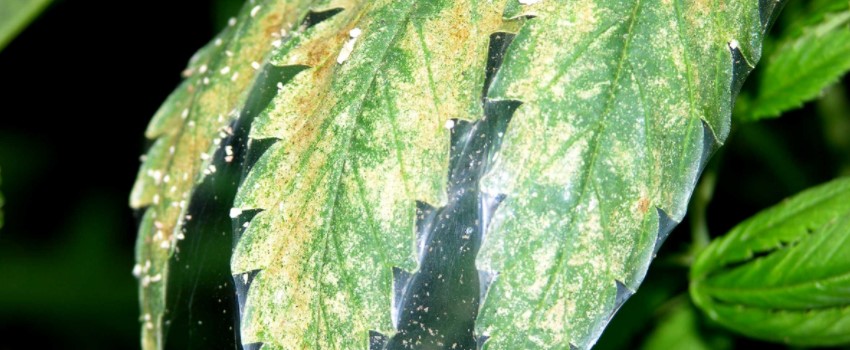
Spider Mites – Image powered by Growweedeasy.com
Spider mites can multiply quickly, and that may be the biggest challenge for the garden. They affect the survival of the plant by taking out nutrients and chlorophyll.
Thrips
Thrips primarily attack the flower of cannabis plants. When the infestation is not controlled, the plants are not likely to mature. Moreover, they can also cause even more damage to the garden by spreading other plant diseases.
Whiteflies
Whiteflies are small flying insects that live on the undersides of the plant. They move quickly and can spread diseases, too.
Environmental Conditions
Environmental conditions can be conducive to the growth of cannabis plants, or it could be stressful. Here are bits and pieces of information that growers want to know of to prevent these external factors from stunting plant growth or worse, killing them.
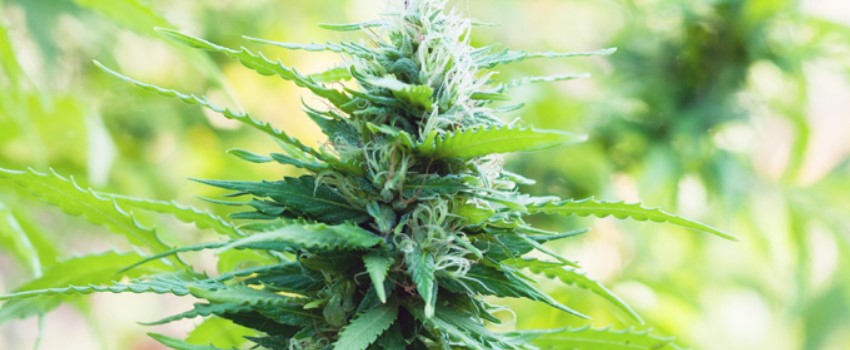
Environmental Conditions- Image powered by Leafly.com
Heat
Most cannabis plants thrive in dry and warm climate. However, when the heat is excessive, it can become fatal. Heat stress is noticeable when there is a change in the color of the leaves. For instance, they turn yellow and curl inward. As such, it is best to have ample shading. Inside a tent, then growers can raise the grow light.
Humidity and Temperature
Humidity refers to the amount of water vapor in the air. As plants breathe the air, they may be getting air that has the right or excessive amount of moisture.
Temperature is also related to humidity. It may directly affect the amount of water vapor the air can sustain. Furthermore, it may even cause the growth of molds and mildew.
Careful monitoring, thus, is vital to not only the survival of the plants but also to optimal growth.
Weather
Sudden changes in the climate can cause undue stress on plants. It may result in abnormalities and other complications. As much as possible, it would be best to have emergency plans in case of severe weather.
Soil
Soil problems can be challenging. It is quite true for those who grow outdoors. Because soils differ, some may or may not be suitable for growing cannabis in its various stages. Hence, growers need to ascertain the type of soil before even cultivating. If it is not suitable, the right ones can be purchased.
Other Problems
Besides nutrient deficiencies, diseases, pest and bugs, and environmental condition, growers can face other challenges or problems.
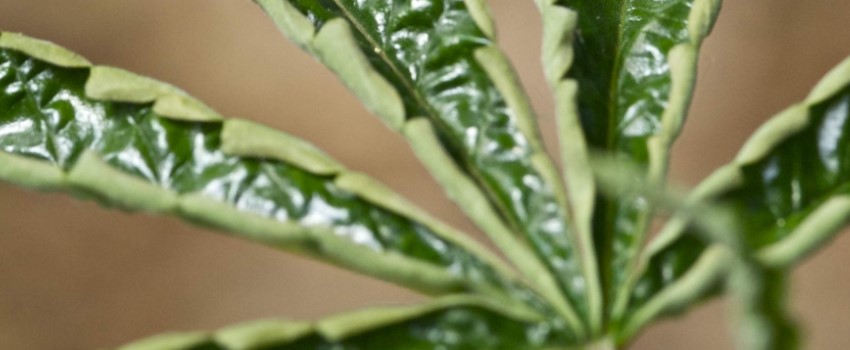
Other Problems – Image powered by Bigbudsmag.com
Airy and Loose Buds
Having airy and loose buds causes various problems. One is that plants will not be able to mature properly. Thus, it results in having less THC production. Moreover, they’ll appear flaccid as they’re not as dense as normal buds.
Stretching
Stem stretching can pose a big problem. What happens is that it can significantly impact plant growth. In this case, it can lower the yields or create weak stems.
Hermaphrodites
Hermaphroditic plants have male and female genitalia. Ideally, the plant is originally female or male. Unfortunately, some factors affect the plant causing it to transform into a hermaphrodite. Either it is genetic or most likely, due to environmental stress.
Plants Will Not Flower
When plants don’t flower, of course, there is an underlying issue. It may be related to light cycle. Growers usually identify it first, so it’s easier to solve the problem.
Knocked Down Plant
Knocked down plants need to be in a secure place. They have to have the necessary support to keep the stem intact and solid. Placing the plants in the right spot makes a lot of difference.
Hard or Soft water

Hard or Soft water – Image powered by Fullhealthsecrets.com
Using hard or soft water in the plants have their advantages and disadvantages.
Hard water contains high doses of calcium and magnesium. It might sound appealing, but it has its downside. Too much calcium may block absorption of other nutrients. In soft water, it doesn’t have a lot of minerals. Sometimes, there’s even not enough at all.
The trick here is to observe for signs of deficiency and adjust accordingly by feeding the right nutrients.
Over- and Under-Watering
Over-watering and under-watering have adverse effects on the plants. Too much or too little water can damage the leaves, stems, and roots of the plants. Good growers use strategies help them prevent over-watering or under-watering their plants.
Identifying Is Part of Solving Plant Problems
As mentioned, growing cannabis is a part of the fun that adds to the cannabis use experience. However, problems arising can be challenging. At times, the damage caused can not only be disheartening or discouraging but also cause one to quit cultivating.
Like many things too, all it takes is an investment in time and effort learning. With the requisite knowledge, these problems are not only detected but also can be prevented from occurring in the first place.


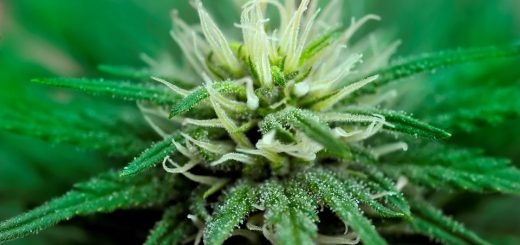
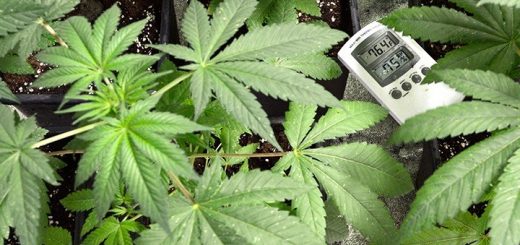
Recent Comments